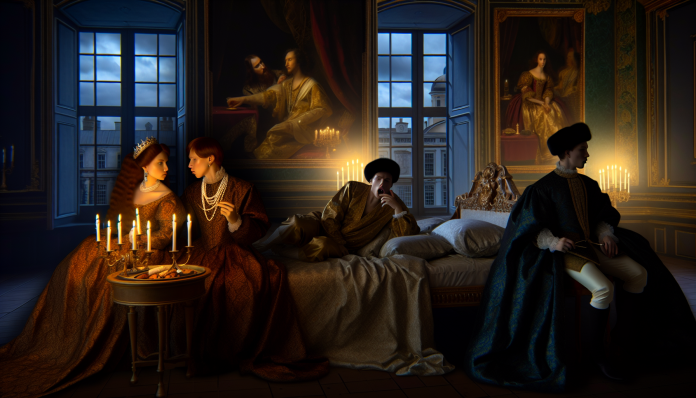Introduction
At the turn of the 20th century, the Russian Empire was one of the most powerful nations in the world, helmed by Tsar Nicholas II and his wife, Alexandra. Despite their opulent lifestyle and royal status, this was a family grappling with secrets, scandal, and the shadows of a crumbling dynasty. At the heart of the turmoil was a love triangle involving Alexandra, her husband Nicholas, and the enigmatic mystic Grigori Rasputin. This scandal would reverberate throughout Russia, ultimately contributing to the downfall of a dynasty that had endured for over three centuries.
Time Period & Societal Norms
During the late 19th and early 20th centuries, Russian society was marked by rigid moral standards, deeply influenced by the Orthodox Church and conservative values. Relationships often adhered to strict norms, with marriage viewed as a sacred institution aimed at procreation and upholding social class. However, the upper echelons of society were often guised in opulence and contradiction, where secret affairs and scandals could simmer beneath the surface, waiting for the right moment to erupt.
The Scandal
The Players: Rasputin, Alexandra, and Nicholas II
Grigori Rasputin, a self-proclaimed holy man and mystic, emerged on the Russian social scene in the early 1900s. His unconventional presence attracted the attention of the royal family, particularly Alexandra, who sought solace in his spiritual guidance during their son Alexei’s struggle with hemophilia. Rasputin’s seemingly miraculous ability to ease Alexei’s pain led to a growing bond with Alexandra, who viewed him almost as a divine figure.
Rasputin’s influence over the Romanovs intensified, creating a powerful nexus of emotional dependency and political tension. As Rasputin became more entwined in royal affairs, whispers of his relationship with Alexandra began to circulate among the aristocracy.
Key Events and Public Reaction
The clandestine partnership would eventually provoke public outrage as rumors of Rasputin’s excessive behavior and Alexandra’s deep emotional connection to him surfaced. Newspaper articles portrayed Rasputin as a lecherous figure, manipulating the naive Alexandra for his gain.
In 1916, discontent boiled over as Rasputin’s influence was linked to Russia’s military failures in World War I. Aristocrats and citizens alike felt betrayed, believing Rasputin was leading Russia to ruin. The perception of Alexandra as a foolish woman under Rasputin’s thrall only fueled the fire.
Then came the fateful night in December 1916 when a group of nobles conspired to assassinate Rasputin. Believing they were saving the monarchy, they lured him to a palace in St. Petersburg. The accounts of Rasputin’s assassination are chaotic. He allegedly endured poison, gunshots, and even drowning before finally succumbing. His death was celebrated by some but fueled deeper animosity toward the Romanovs.
Moral and Cultural Analysis
Societal Reaction
The scandal surrounding Rasputin and the Romanovs revealed significant societal tensions. On one hand, the 19th-century Russian nobility was steeped in tradition and conservative values that dictated propriety. The notion of a royal having an emotional or intimate relationship with a common man (no matter how influential he was perceived to be) was nothing short of scandalous.
Conversely, Rasputin’s popularity among certain segments of the population created a dichotomy; many saw him as a mystic who had genuine prophetic abilities, while others viewed him as a malevolent force corrupting the royal family. Ultimately, this split perception became a metaphor for the disillusionment many felt toward the imperial government—a symbol of a failed system.
Consequences for Those Involved
The fallout from this scandal was disastrous for the Romanov dynasty. Alexandra became a target for public scorn, viewed as the pillar of the family’s instability. The culmination of this turmoil came in 1917 when the Russian Revolution erupted, leading to the abdication of Nicholas II and the eventual execution of the entire family in 1918—an outcome that would cement their legacy as tragic figures embodying the end of imperial Russia.
Modern Perspectives
Fast forward to today, and the love triangle between Alexandra, Nicholas, and Rasputin might be seen through a lens influenced by contemporary views on personal freedom and sexuality. Modern audiences would likely approach the emotional dynamics of the relationship with empathy, recognizing Alexandra’s isolation and the societal pressures she faced as a royal.
In a world that increasingly values individual autonomy, a scandal like this could provoke discussions about the complexities of human relationships—beyond mere infidelity to the exploration of deeper emotional needs and familial pressures. Furthermore, Rasputin’s role could be analyzed as part of a larger conversation about the impact of power dynamics and charisma on personal relationships.
Conclusion
The love triangle that involved Alexandra, Nicholas II, and Grigori Rasputin serves as a poignant example of how sex, power, and personal freedom have shaped historical narratives. It reflects the intricate ways in which society’s moral standards can influence individual lives, with consequences that echo through history.
As we delve into these stories from the past, it is vital to remember that they continue to resonate today. They challenge us to question how far we’ve come in our understanding of relationships, power, and agency, urging us to think critically about the historical influences that shape our modern values.
As we reflect on the scandalous intricacies of the Romanov dynasty, let’s embrace the complexity of love’s many forms and the responsibilities that come with power, recognizing that history is not merely a record of the past but a teacher for our future.

